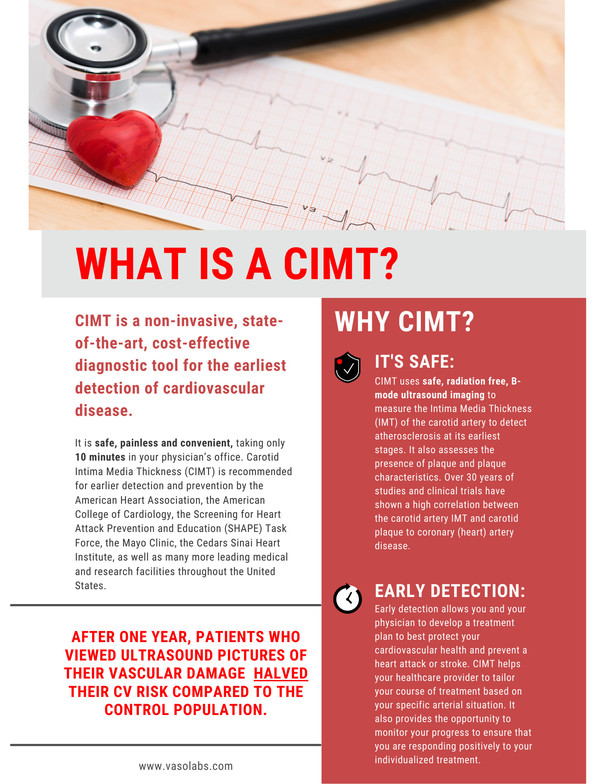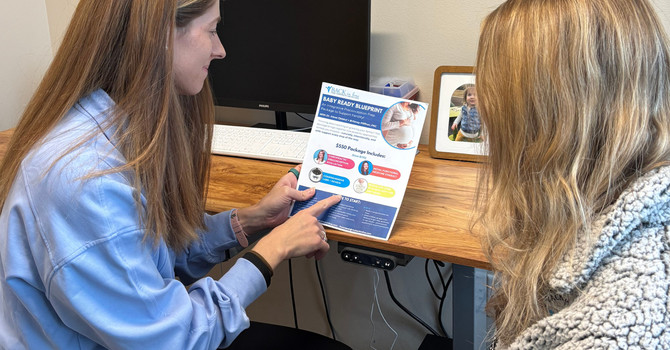
What’s the buzz about??? Further explanation anddiscussion of CIMT.
By now you have heard that Back in Line is proud to offer Integrative cardiovascular workups. There are many things this includes, but one of our main components which we are very proud of is being able to offer in-office Carotid Intima-Media thickness ultrasounds(CIMT). You may be asking yourself, how is this different from a traditional carotid ultrasound which you may have had in the past. By the end of this blog post, we hope you have a much better understanding and share our enthusiasm for what’s to come!
All blood vessels have two walls and the carotids are no different. They have an inner wall and an outer wall with three main layers in between. The endothelium is a single celled layer that is on the inner most aspect of the blood vessels, coming in contact with the blood. This acts as the barrier for all things entering and leaving the vessel wall, going back into circulation. The endothelium is also responsible for making nitric oxide, the main factor needed to allow vessels to relax(vasodilation). Just inside the endothelium is the intima. The intima and the middle layer, the media, is what is measured during the CIMT. The intima is where cholesterol can be deposited (atherosclerosis) first before the body makes flow limiting plaques within the vessel lumen. If we can detect thickened walls, we can address this hopefully before plaques form.
This is one of the main differences between CIMT and a carotid ultrasound. Carotid ultrasounds do not give us the wall thickness, therefore making it hard to detect subclinical atherosclerosis.
Why is it so important to identify wall thickness within the carotid arteries before plaques have formed?
- There is a direct correlation between the amount of plaque in the carotid arteries and in the coronary arteries(the arteries that feed the heart wall). While the exact percentage/correlation between the carotids and coronary arteries is unknown, it is safe to assume that “what is going on the carotids is going on in the coronaries.” These plaques are what cause heart attacks and strokes.
- Diet, lifestyle, supplements and in some cases pharmacotherapy can help to decrease carotid wall thickness. It is REALLY hard to reverse carotid plaques once they have formed. There are ways to slow the progression and to harden or stabilize the plaques, but it is hard to reverse the plaques.
Another important aspect to point out in regards to CIMT is that it can give us the nature of the carotid plaque. This means the report will tell us if the plaque is hard, soft or a mixture of both. Soft plaques are more prone to rupture since there is no hard, fibrous cap holding it in place.
How is it performed?
CIMT is an ultrasound. Currently, Jill Reese is the only provider at Back in Line doing scans. The patient would be asked to lay flat, or inclined slightly. A mobile ultrasound probe is used to scan the right carotid artery first, bottom to top. Thirty second videos are then taken of the carotid anatomy from approximately your collar bone(clavicle) stopping under the jaw. This process is then repeated on the left side. The videos are then sent to Vasolabs. Back in Line has contracted with Vasolabs to give us a fantastic report that gives us measurements of the intima-media thickness, percentile based on age, measurement of the plaques found in the carotids and vascular age. Vascular age is based on a large population based study of mostly healthy individuals. The patient’s intima-media thickness is then plotted on a graph based on gender and age, and that is who the vascular age is determined. This study had over 10,000 people for reference. There is NO radiation exposure during this test. Reports are usually produced within one week of the test being completed.
What do I do with my results, and what if they are not good?
Jill or the Back in Line front desk will reach out to you once the results are published. You will also be notified on a secure email and can view your results from home. Part of the charge for the CIMT includes a 10 minute follow up that will be scheduled when you check out after your ultrasound. The patient can choose whether you would like just a video overview with findings and suggestions moving forward or you would like to come in and discuss in person.
We feel that seeing is believing. If a patient is presented with findings consistent with wall thickening, signs of early atherosclerosis, have an elevated age above their actual biological age, have plaques within the carotid arteries, this will help mobilize positive health changes. CIMT scans can be done yearly although there is currently no large association that recommends routine testing of CIMT. Vasolab reports also give the patient a percentile based on age and gender. Above the 75th percentile puts a patient at high risk for cardiovascular events(1). All healthy lifestyle changes start with the basics of exercise and clean eating. Cholesterol can deposit when the endothelium is damaged. This can be from a number of things but systemic inflammation is one of the main causes. This can be from gut problems, insulin resistance and more. This would be crucial to investigate if the CIMT findings are worrisome for the individual. Advanced lipid testing, sources of inflammation, etc can be ordered by Jill Reese or Dr. CJ and obtained at the new lab drawing station at Back in Line.
FAQ’s
- What is the cost of the test? Back in Line charges $350 for the test which includes the follow up visit to discuss results.
- Does the test hurt? No, the test is painless.
- Do I need to do anything to prepare for the test? No, just remove any jewelry around your neck.
- Does insurance cover CIMT? We have been unable to find any private or public insurances that will cover CIMT testing.
- I have had Life Line screening in the past? How is this different? In our opinion, CIMT along with Vasolabs really delivers that piece of EARLY detection and prevention. Life Line screenings will bring to light established carotid plaques; while good to know, doesn’t allow you to truly fix the problem before it starts. If you detect early wall thickness within the carotid arteries, this means you have excessive cholesterol, inflammation, etc and can identify the problem early and hopefully reverse or prevent worsening.
- How often are CIMT scans offered at Back in Line? Unlike other companies that do CIMT scans, the business/clinic sponsoring the scans have to coordinate a traveling ultrasound tech. At Back in Line, based on Jill Reese’s schedule, you could schedule your CIMT any day she is in the office. In our opinion, this providers superior convenience to our patients!
Who would benefit from a CIMT?
- Anyone around the age or soon to turn 40
- Anyone who has been diagnosed with elevated cholesterol or is on a statin
- Anyone with early family history of heart disease(before the age of 55)
- Anyone who has been recommended a statin in the past but would like a second opinion to see if it is truly needed
- Anyone with risk factors for atherosclerosis or heart disease such as diabetes, autoimmune diseases, smoker, etc.
- Anyone curious about their vascular age and to assess if their current diet and lifestyle is benefitting their overall health
- Males with a history of ED
- Anyone with a history of obstructive sleep apnea
What are some things you can do to help your vascular age or CIMT measurements?
- In our opinion, you have to fix your foundation of health before anything. This would include the American Heart Association's “Life's essential 8”: heart healthy diet, 150 minutes of moderate activity weekly, avoid smoking or second hand smoking, aim for 7-9 hours of sleep a night, aim for a healthy body weight(recommended BMI less than or equal to 25), advanced lipid testing, Aic less than 5.7 or fasting blood sugar less than 100, blood pressure below 120/80(2)
- Supplement examples include but not limited to: high dose omega 3s, bergamot, berberine, antioxidants such as vitamin C, vitamin E, CoQ10, glutathione, etc.
- Pharmacotherapy such as statins based on one’s risk assessment and overall health picture
How to schedule your CIMT scan today
Book with Jill today! Or call the front desk at 319-892-3363.
Sources:
- Wong, Nathan D. ASPC Manual of Preventative Cardiology. Humana Press, 2021. 8 Aug 2024, pp 393.
- https://www.heart.org/-/media/Healthy-Living-Files/Well-being-Works-Better/my_life_check_brochure.pdf



